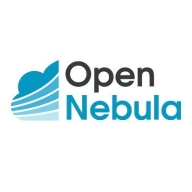

VMware Cloud Director and OpenNebula operate in the cloud infrastructure platform market, with VMware Cloud Director being more suited for enterprise-level deployments due to its comprehensive service offerings, scalability, and advanced features. OpenNebula, on the other hand, appeals to smaller operations because of its open-source nature and ease of use.
Features: VMware Cloud Director is known for extensive cloud service offerings, multi-tenancy, and integration abilities with VMware’s suite, making it robust for enterprise use. OpenNebula is appreciated for its lightweight nature, simple deployment, and support for multiple hypervisors, offering flexibility as a cloud management platform.
Room for Improvement: VMware Cloud Director could enhance its public cloud integration, simplify user experiences, and improve HTML5 support. Users seek better alignment with AWS or Azure. OpenNebula requires stronger community support, better template management capabilities, and advanced cloud features to compete effectively with rivals.
Ease of Deployment and Customer Service: VMware Cloud Director offers flexible deployment options across various cloud environments, though setup can be complex. Its customer support receives mixed reviews concerning timeliness. Conversely, OpenNebula is praised for straightforward deployment in on-premises setups and customer service simplicity.
Pricing and ROI: VMware Cloud Director's high costs may not suit budget-constrained projects, although its benefits can lead to substantial ROI over time due to enhanced service delivery. OpenNebula, with its cost-effective approach, especially for open-source users, presents an attractive pricing model, delivering quick ROI through low initial investments and operational savings.
| Product | Market Share (%) |
|---|---|
| VMware Cloud Director | 4.9% |
| OpenNebula | 5.1% |
| Other | 90.0% |


| Company Size | Count |
|---|---|
| Small Business | 7 |
| Midsize Enterprise | 6 |
| Large Enterprise | 3 |
| Company Size | Count |
|---|---|
| Small Business | 24 |
| Midsize Enterprise | 11 |
| Large Enterprise | 36 |
OpenNebula provides the most simple but feature-rich and flexible solution for the comprehensive management of virtualized data centers to enable private, public and hybrid IaaS clouds. OpenNebula interoperability makes cloud an evolution by leveraging existing IT assets, protecting your investments, and avoiding vendor lock-in.
OpenNebula is a turnkey enterprise-ready solution that includes all the features needed to provide an on-premises (private) cloud offering, and to offer public cloud services.
VMware Cloud Director, also known as vCloud Director, is a cloud management tool that offers secure, flexible, and efficient cloud resources to thousands of enterprises and IT teams across the world. The solution serves as one of the leading cloud service-delivery platforms for businesses that want to manage and operate their services effectively. By deploying this solution, companies can benefit from virtualized networking, computing, security, and storage. These benefits can be received in a timely manner, as the infrastructure of the product is operationally ready within minutes and clients do not need to install and configure physical infrastructure.
One of the biggest advantages of vCloud Director is that it allows users to build cloud-ready applications. In several ways, it facilitates the process for developers, including:
vCloud Director Features
This VMware product has various features through which users can virtualize their data and benefit from quality management solutions. Among the popular capabilities of vCloud Director are:
vCloud Director Benefits
VMware vCloud Director offers various benefits to its users. Some of these include:
Reviews from Real Users
Ajit Y., a cloud architect at a computer software company, likes VMware vCloud Director because it is a stable, truly multitenant software and the go-to tool for infrastructure as a service.
Kashif F., a divisional engineer at National Telecom Corporatio, rates vCloud Director highly because the product can be used for infrastructure provisioning without using a platform service.
We monitor all Cloud Management reviews to prevent fraudulent reviews and keep review quality high. We do not post reviews by company employees or direct competitors. We validate each review for authenticity via cross-reference with LinkedIn, and personal follow-up with the reviewer when necessary.